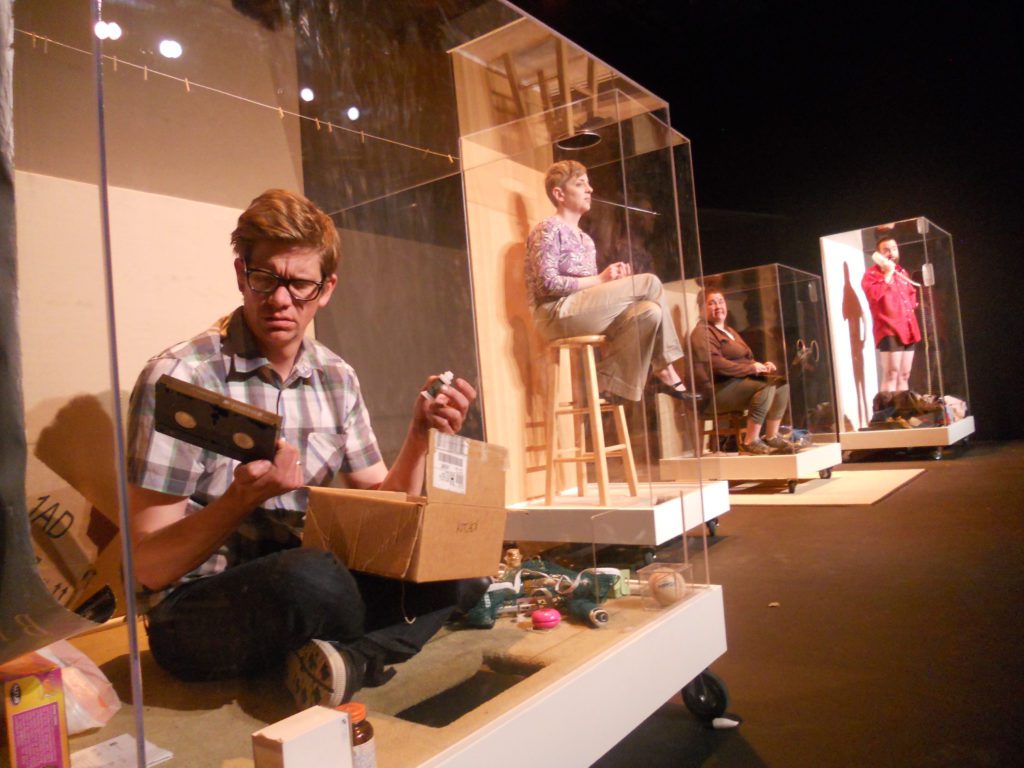It was — and fortunately remains — quite the weekend for intriguing theater.
I was going to say “unusual” theater. And although Buntport Theater’s latest original work “Middle Aged People Sitting in Boxes” is a quirky take on modern identity, doing playfully ruminative work is hardly unusual for this five-person company.
Four large rectangles draped with black fabric sit on the concrete floor of the theater. They are boxes big enough to hold a person; each has three sides and a ceiling of Plexiglass.
As promised, there are people already in these containers. And as the pre-performance music grows faint, each performer pulls at the curtain to reveal themselves.
In this show, the actors go by their own names, which doesn’t mean they aren’t characters. Over the course of the show, Erik Edborg’s box will get cluttered as he unpacks little cardboard cartons of stuff.
Erin Rollman, who’s maintaining the Facebook page for her 25th high school reunion, stands or leans or sits on a stool in her more vertical habitat.
A laptop often in her lap, Hannah Duggan sits typing away on the keyboard. Brian Colonna’s pen has a pile of laundry on its floor. He’s in boxer briefs, a phone in his hand.
There are holes cut into the Plexiglass that aren’t particularly noticeable until a character does something odd: like sidle up to another box or gather laundry from a clothesline stretched across the stage or plug a vacuum in to an extension cord to take a swipe at a rug.
Colonna doesn’t just have a land line, his old-school phone is tethered to a wall jack outside his box. That Muzak-like sound — diabolically imagined by frequent collaborator Adam Stone — is actually the punishing drone of being Colonna on hold.
Familiarity breeds contemplation in “Middle Aged People Sitting in Boxes.”
Rollman starts things off early with questions about what exactly constitutes “middle age”? It’s not a bad quandary in a society that half jest that “50 is the new 30” and so forth. What to make of one’s place on a spectrum between twenty-something and “elderly.”
That this quartet hardly seems “middle age” to this late Boomer is part of the point in this exploration of generational identity.
What are the indicators, the indices that define us? What boxes do we check to claim our space in a overly connected society? And how connected are these characters, really, in a world in which a comforting hug meets Plexiglass?
What are the account numbers and passwords that make a galling, if useful, claim on who we are? Until, that is, they’re misplaced and you must seek the compassion of some faceless, practiced customer service rep, as Colonna experiences in his looping purgatory of hold.
Central to the sly artistry of this ensemble are the offstage machinations of fellow Buntporter SamAnTha Schmitz, who applies layers of light and sound to what appears a stripped show. “Middle Aged People Sitting in Boxes” has deceptively spare staging.
And at times the characters’ riffs have the rhythmic pay-offs of stand-up routines. But four stand-ups weaving their acts is no easy feat. What seems cleverly conversational is highly orchestrated. The casual and flippant serves a philosophy of our quotidian, our daily lives shaped by memories and shot through with way too much information.
That mixture can be amusingly inane It can be magical. Occasionally it can be both.
-Lisa Kennedy, April 23, 2015 Denver Post







